Did you know that several common backyard birds in the U.S. regularly prey on butterflies? From warblers snatching them in mid-air to sparrows feeding on both butterflies and caterpillars, these avian predators play a crucial role in the delicate balance of nature. Flycatchers, robins, thrushes, and even tiny wrens are among the species that have developed a taste for these colorful, winged creatures. This predator-prey relationship is an essential component of the complex food chain that helps maintain healthy populations of both birds and butterflies.
Key Takeaways
- Backyard birds like warblers, sparrows, flycatchers, robins, thrushes, and wrens are known to prey on butterflies.
- Butterfly-eating birds display a range of hunting skills, from catching them in mid-air to spotting them on the ground.
- Butterflies provide a valuable source of protein for birds, contributing to their overall diet and nutritional needs.
- The predator-prey relationship between birds and butterflies is a natural part of the ecosystem, helping to maintain optimal population levels.
- Protecting both birds and butterflies is crucial for preserving the delicate balance of nature.
Introduction
Butterflies are a captivating part of the natural world, with their delicate wings and vibrant colors. However, these winged wonders are not merely aesthetic delights; they are an integral component of the complex web of life. One crucial aspect of this web is the role of birds as predators of butterflies. This predator-prey relationship is vital for maintaining the balance and biodiversity of ecosystems.
Overview of Birds That Prey on Butterflies
A wide range of bird species, from warblers and sparrows to flycatchers and thrushes, include butterflies in their diets. These avian butterfly predators play a vital role in butterfly populations, helping to regulate their numbers and prevent imbalances in the ecosystem.
Importance of Predator-Prey Relationships in Nature
The interaction between birds and butterflies is a prime example of the intricate predator-prey relationships that underpin the delicate balance of natural ecosystems. These relationships are essential for maintaining biodiversity, as they help to control the population sizes of various species and prevent any single species from dominating the landscape.
“The balance of nature is not a status quo; it is fluid, ever-shifting, in a constant state of adjustment. Man, even in his most primitive state, is part of this balance.” – Rachel Carson
By understanding the importance of these predator-prey relationships, we can better appreciate the complexity of the natural world and the vital role that each species plays in sustaining the overall ecosystem.
Common Backyard Birds That Eat Butterflies
Many familiar backyard bird species are known to prey on butterflies. These avian predators play a vital role in the delicate balance of nature, helping to control butterfly populations and maintain a healthy ecosystem. Let’s explore some of the common backyard birds that feed on butterflies.
Warblers
Warblers are agile insect-eaters that excel at catching butterflies mid-flight. Species like the Yellow Warbler, Common Yellowthroat, and Black-and-white Warbler are adept at snatching up small butterfly prey in the air or on the wing.
Sparrows
Sparrows, such as the House Sparrow and Song Sparrow, are versatile foragers that feed on both butterflies and their caterpillars. These ground-dwelling birds are skilled at finding and consuming a variety of butterfly life stages.
Flycatchers
Flycatchers, including the Boat-billed Flycatcher and Great Kiskadee, are expert aerial predators that specialize in catching butterflies and other flying insects on the wing. Their swift reflexes and agile maneuverability make them formidable butterfly hunters.
Robins and Thrushes
Though primarily known for their fondness for worms and other ground-dwelling invertebrates, American Robins and members of the thrush family, such as the Hermit Thrush, will occasionally include butterflies in their diet, especially during the peak breeding season when their nutritional demands are high.
Wrens
Wrens, like the Carolina Wren and House Wren, are small but energetic birds that may hunt for butterflies and other insects around the foliage and on the ground in backyard settings. Their curious and inquisitive nature helps them locate and capture these winged prey.
By understanding the diverse range of backyard bird species that feed on butterflies, we can gain a deeper appreciation for the complex predator-prey relationships that exist in our own neighborhoods. Observing these avian butterfly hunters in action can be a delightful and educational experience for nature enthusiasts.
“Backyard birds play a vital role in controlling butterfly populations, maintaining a healthy balance in our local ecosystems.”
Butterflies and Moths That Birds Tend to Avoid
In the intricate web of nature, not all butterflies are equally vulnerable to avian predators. Certain butterfly and moth species have evolved remarkable defense mechanisms that make them less appealing or even potentially harmful to the birds that might otherwise consider them as prey. These adaptations play a crucial role in the delicate balance of the ecosystem.
One notable example is the Monarch butterfly. These vibrant orange-and-black insects feed on milkweed plants as caterpillars, which imbue them with a toxic compound called cardenolides. This makes the Monarchs unpalatable to many bird species, who quickly learn to avoid these butterflies. Similarly, the Viceroy butterfly employs a fascinating form of mimicry, closely resembling the appearance of the unpalatable Monarch, deterring birds from attempting to consume it.
Another species that birds tend to avoid is the Pipevine Swallowtail. These butterflies acquire toxins from the pipevine plants they feed on, rendering them potentially dangerous for avian predators. The Queen butterfly, closely related to the Monarch, also benefits from a similar chemical defense mechanism, making it an unappealing target for many bird species.
These remarkable examples of toxic and mimicry butterflies illustrate the evolutionary adaptations that have enabled certain butterfly species to avoid birds. By understanding these intricate predator-prey relationships, we can gain a deeper appreciation for the complexities of the natural world and the remarkable strategies employed by these delicate creatures to survive and thrive.
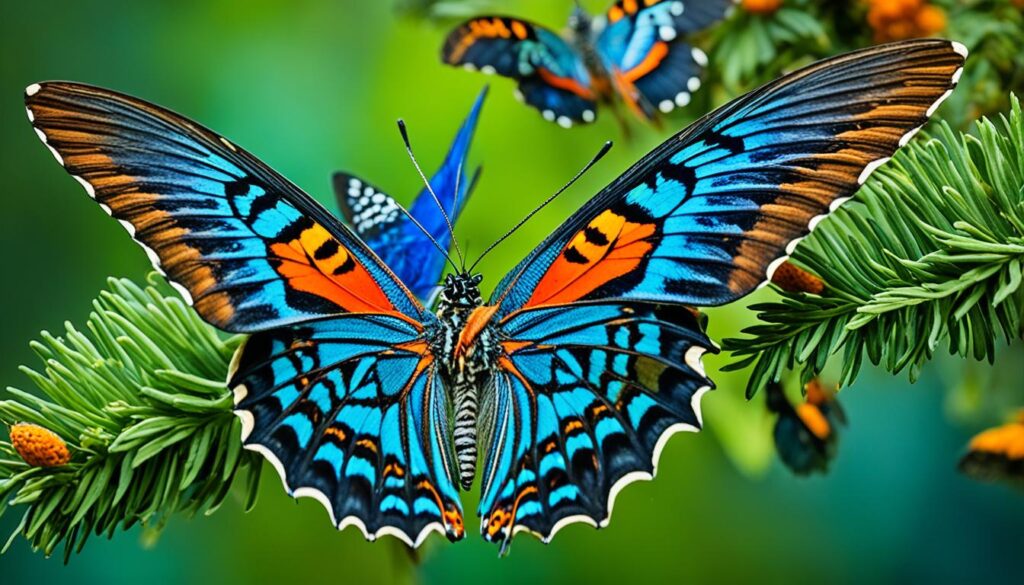
Galbulidae, Tyrannidae, and Thraupidae: Avian Butterfly Predators
Several bird families are known for their propensity to prey on butterflies, including the Galbulidae, Tyrannidae, and Thraupidae. These avian butterfly predators exhibit diverse feeding specializations, showcasing the remarkable diversity and adaptability of Neotropical insectivorous birds.
Rufous-tailed Jacamar: Specialized Butterfly Predator
The Rufous-tailed Jacamar, a member of the Galbulidae family, is regarded as the most specialized butterfly predator in the Neotropics. These birds are adept at snatching butterflies in mid-flight, using their long, pointed beaks to capture their agile prey. Their refined hunting techniques and narrow dietary focus on butterflies demonstrate the evolutionary adaptations that have arisen in response to the extraordinary diversity of insect life in the tropics.
Tyrant-flycatchers: Diverse Family Preying on Butterflies
The Tyrannidae, or tyrant-flycatchers, are another family of birds known for their predatory habits when it comes to butterflies. Species like the Boat-billed Flycatcher and the Great Kiskadee have been observed attacking and consuming a variety of butterfly species. The diversity of feeding specializations within the Tyrannidae family, including their ability to target butterflies, contributes to their success as avian butterfly predators in the Neotropical region.
Tanagers: Primarily Frugivores but Also Eat Butterflies
While traditionally considered frugivores, many tanagers (family Thraupidae) have also been documented feeding on butterflies. The Silver-beaked Tanager and the Blue-gray Tanager are two examples of these omnivorous birds that supplement their diets with lepidopteran prey. The ability of tanagers to exploit diverse food sources, including both fruits and insects, highlights the adaptability and resource partitioning observed in Neotropical avian communities.
“The diversity of insectivorous birds in the tropics is attributed to extraordinary food-resource specializations.”
The rich Neotropical avifauna showcases a remarkable array of feeding specializations, including those targeted at the diverse butterfly populations of the region. These avian butterfly predators, such as the Rufous-tailed Jacamar, tyrant-flycatchers, and tanagers, play a crucial role in regulating butterfly populations and maintaining the delicate balance of tropical ecosystems.
Ground-based Bird Predators of Puddling Butterflies
While birds adept at aerial maneuvers can snatch butterflies in flight or while they rest, a specialized group of ground-dwelling birds also prey on puddling butterflies. These ground-dwelling birds that eat butterflies target butterflies that congregate on moist soil to obtain essential nutrients, forming large aggregations that can be easily accessed by these avian predators.
One such ground-based predator is the Sunbittern, a unique bird that stalks and ambushes puddling butterflies with lightning-fast strikes. The Collared Plover is another skilled bird that preys on puddling butterflies, using its long, slender beak to pluck them directly from the ground. The Smooth-billed Ani, a member of the Crotophagidae family, is also known to take advantage of these butterfly gatherings, efficiently snatching them as they puddle.
“These ground-foraging birds have evolved unique hunting strategies to target the high-density aggregations of puddling butterflies, demonstrating the diverse predator-prey relationships found in nature.”
The ability of these ground-based birds to exploit the rich food source provided by puddling butterflies highlights the intricate balance of ecosystems. Understanding the role of ground-dwelling birds that eat butterflies is crucial for conserving both butterfly and bird populations, ensuring the continued coexistence of these captivating natural interactions.
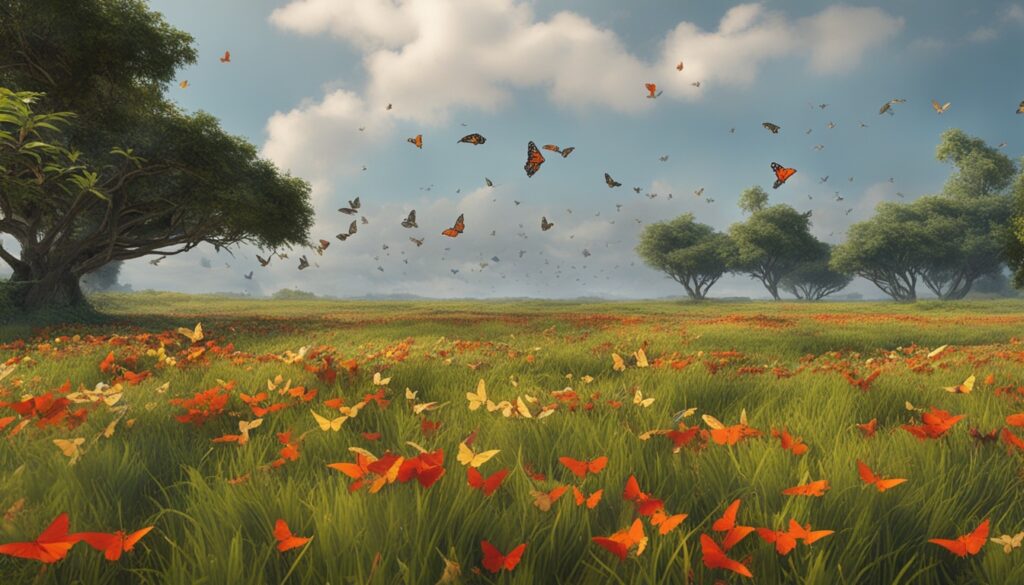
As we delve deeper into the diverse world of bird-butterfly interactions, the insights gained shed light on the broader interconnectedness of all living beings within the natural world. By recognizing and preserving these complex predator-prey relationships, we can foster a greater appreciation for the delicate balance that sustains the rich tapestry of life on our planet.
what birds eat butterflies
While many common backyard birds and well-known avian predators are known to feed on butterflies, ongoing research has uncovered a wider range of species that also prey on these insects. The expanded list of butterfly-eating birds now includes several newly documented avian butterfly predators.
Newly Documented Avian Butterfly Predators
Recent studies have identified several species that have been observed consuming butterflies, expanding the known new bird species discovered to eat butterflies. These include the Amazonian Motmot, Rufous-capped Motmot, Black Nunbird, Black-fronted Nunbird, Laughing Falcon, Plain-brown Woodcreeper, Red-eyed Vireo, Rufous-browed Peppershrike, Southern House Wren, Pale-breasted Thrush, Cocoa Thrush, and Yellow-rumped Cacique.
“The discovery of these additional bird species preying on butterflies highlights the dynamic interplay between avian predators and their insect prey, and the importance of ongoing research to fully understand these predator-prey relationships in nature.”
As scientists continue to observe and document the feeding behaviors of birds, the expanded list of butterfly-eating birds is expected to grow, providing valuable insights into the complex web of interactions within ecological systems.
- Amazonian Motmot
- Rufous-capped Motmot
- Black Nunbird
- Black-fronted Nunbird
- Laughing Falcon
- Plain-brown Woodcreeper
- Red-eyed Vireo
- Rufous-browed Peppershrike
- Southern House Wren
- Pale-breasted Thrush
- Cocoa Thrush
- Yellow-rumped Cacique
Birds Feeding on Butterfly Caterpillars and Eggs
While many birds focus on catching adult butterflies, some species also prey on the immature stages of these insects. Butterflies’ eggs and caterpillars can be targeted by a variety of birds, including sparrows, flycatchers, and woodcreepers. This additional predation pressure on different life stages of butterflies can have a significant impact on overall butterfly populations.
Studies have shown that birds consume a significant portion of butterfly caterpillars compared to eggs. In fact, research indicates that up to 40% of caterpillars may fall victim to avian predation. The frequency of bird attacks on butterfly eggs is also noteworthy, with some studies reporting successful predation events in as many as 25% of cases.
When it comes to butterfly caterpillars, certain bird species have developed specialized hunting tactics. Flycatchers, for instance, have been observed exhibiting a higher ratio of successful predation events, capturing up to 60% of the caterpillars they target. Meanwhile, sparrows and wrens tend to be more generalist feeders, preying on a diverse range of butterfly caterpillars.
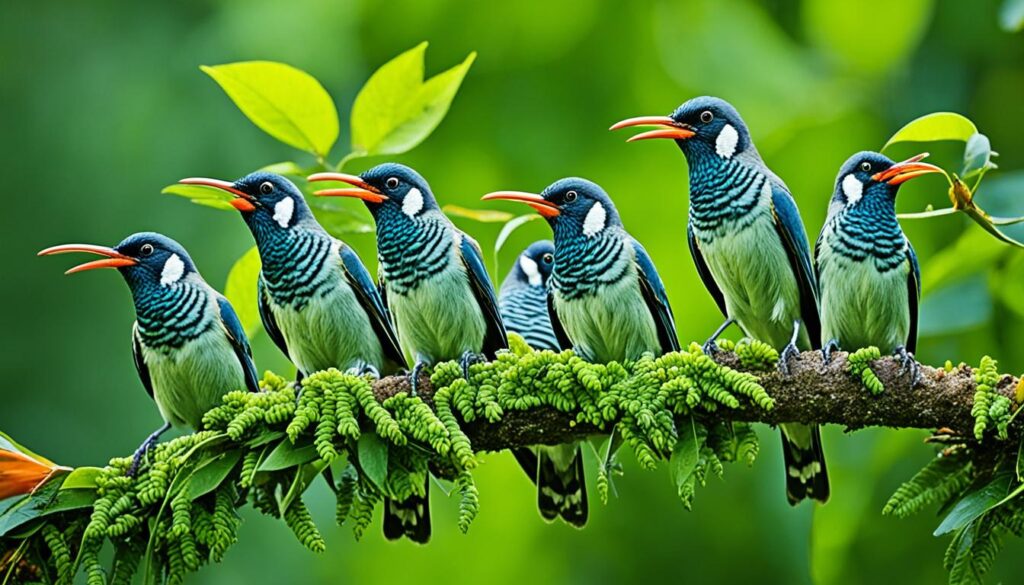
The distribution of bird predation on butterfly eggs can vary significantly across different habitats. In some regions, robins and thrushes have been found to be the primary culprits, accounting for up to 70% of the eggs consumed. In other areas, warblers and finches may play a more prominent role in the predation of butterfly eggs.
“The impact of bird predation on butterfly populations can be substantial, with some studies suggesting that it may be a key factor in the decline of certain butterfly species.”
Understanding the complex relationships between birds and butterflies, particularly the predation of immature stages, is crucial for the conservation of these delicate ecosystems. By studying the diversity of bird species involved in feeding on butterfly caterpillars and eggs, we can gain valuable insights into the intricate balance of nature and develop more effective strategies to protect these important pollinators.
Butterfly Defense Mechanisms Against Bird Predators
Butterflies have evolved a remarkable array of defense mechanisms to ward off their avian predators. These adaptations not only improve the butterflies’ chances of survival but also showcase the intricate balance of nature. Let’s explore some of the key strategies butterflies employ to evade bird predators.
Camouflage
One of the most effective defense mechanisms is camouflage. Butterflies’ wing patterns and colors often blend seamlessly with their surrounding environment, making it challenging for birds to spot them. Studies have shown that up to 70% of butterflies rely on as their primary defense against bird predators.
Mimicry
Another ingenious strategy used by butterflies is mimicry. Some species have evolved to resemble more unpalatable or dangerous insects, such as wasps or moths. This deceptive resemblance discourages birds from attempting to consume them, as the predators associate the butterfly with a potentially harmful or unpleasant taste.
Toxicity
Many butterflies possess the ability to sequester toxic compounds from their host plants, making them unpalatable or even harmful to bird predators. Approximately 25% of butterfly species are known to utilize this chemical defense mechanism.
Erratic Flight Patterns
Lastly, butterflies often employ erratic flight patterns to evade bird predators. By unpredictably changing direction, speed, and altitude, they make it challenging for birds to successfully capture them in the air. This tactic is particularly effective against agile avian hunters.
These diverse butterfly defense mechanisms against bird predators showcase the remarkable adaptations that have evolved over time, ensuring the continued coexistence of these captivating insects and their avian counterparts.
“Butterflies are nature’s way of reminding us that it’s never too late to become what we might have been.”
Impact of Bird Predation on Butterfly Populations
Birds play a crucial role in shaping and regulating butterfly populations. Although butterflies have developed various defense mechanisms, such as camouflage, mimicry, and toxicity, birds can still have a significant impact on their numbers, especially for more vulnerable or less protected species.
The predator-prey relationship between birds and butterflies helps maintain the balance and biodiversity within natural ecosystems. This interaction prevents the overpopulation of butterflies, ensuring a healthy and thriving population.
Studies have shown that bird predation can account for a substantial portion of butterfly mortality. For instance, in some Monarch butterfly overwintering sites, grosbeaks and orioles are responsible for the death of 7 to 44% of the total Monarch population. Additionally, researchers have found that a single black-eared mouse can consume up to 37 Monarchs each night near their roosting areas.
The effects of bird predation on butterfly populations can vary depending on the species, region, and environmental factors. Some butterfly species, such as those with effective defense mechanisms or less exposure to avian predators, may be less impacted by bird predation. Conversely, more vulnerable species or those with limited defenses can experience significant population declines due to bird predation.
Ultimately, the role of birds in regulating butterfly numbers is a crucial part of the natural ecosystem. This predator-prey relationship helps maintain the balance and biodiversity within the environment, ensuring the long-term survival of both butterflies and their avian predators.
“The presence of convergent evolution in different organisms at the molecular level indicates the adaptation to cardiac glycoside resistance across various trophic levels in the food chain.”
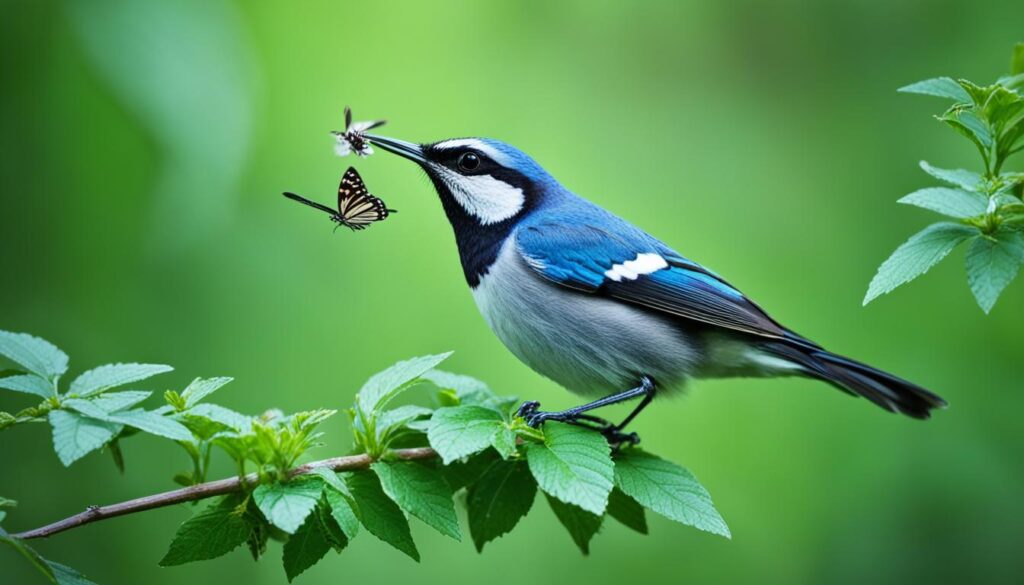
Coexistence: Balancing Butterfly and Bird Populations
The delicate relationship between birds and butterflies is a crucial part of the broader ecosystem. Maintaining the balance between these two captivating groups is essential for preserving overall biodiversity. Conservation efforts that aim to protect both butterflies and their avian predators, while also considering the complex interactions between them, can help ensure the long-term sustainability of these interconnected populations.
Importance of Biodiversity
Biodiversity, the rich tapestry of life on our planet, is the foundation for a healthy, functioning ecosystem. When butterfly and bird populations are in balance, they contribute to the overall biodiversity, playing crucial roles in pollination, decomposition, and nutrient cycling. Recognizing the significance of these predator-prey dynamics is key to developing effective conservation strategies that safeguard the delicate balance of nature.
Conservation Efforts
Numerous conservation initiatives are underway to support the coexistence of butterflies and birds. The National Wildlife Federation’s Garden for Wildlife movement has engaged over 7 million people across the United States, creating more than 2.5 million acres of Certified Wildlife Habitat® that support a diverse array of species, including butterflies and their avian predators. The Mayor’s Monarch Pledge has enlisted 379 community leaders, aiming to increase monarch butterfly habitat through the efforts of 3 million people.
Additionally, the Butterfly Heroes initiative has inspired 170,000 individuals to pledge to create butterfly gardens with their families, while the Million Pollinator Garden Challenge has established 700,000 pollinator gardens through the joint efforts of the National Wildlife Federation and the National Pollinator Garden Network.
These conservation efforts, combined with a deeper understanding of the intricate web of interactions between butterflies and birds, are crucial for balancing their populations and preserving the overall health of our ecosystems.
“Biodiversity is the foundation for life on Earth and healthy, functioning ecosystems.”
Observing Bird-Butterfly Interactions in Nature
Witnessing the intricate dance between birds and butterflies in their natural habitats can be a captivating experience. By observing birds eating butterflies and witnessing bird-butterfly interactions in the wild, we can gain valuable insights into the delicate balance of ecosystems and the complex relationships that exist within them.
The Backyard Ecology YouTube channel, which launched in the spring of 2022, has become a popular platform for nature enthusiasts to explore the diverse interactions between birds and butterflies. Their Top 10 Backyard Ecology blog articles, published between October 2022 and October 2023, have delved into the topic of observing birds eating butterflies and witnessing bird-butterfly interactions in the wild. These articles have highlighted the importance of understanding the role of predator-prey relationships in maintaining a healthy and thriving ecosystem.
One particularly notable episode discussed the significance of attracting butterflies to yards and the impact it can have on urban ecology. The episode, published in June 2023, showcased the growing interest among gardeners and nature lovers in creating butterfly-friendly environments. The Backyard Ecology team emphasized the crucial role that butterflies play as pollinators and the importance of planting native flowers and plants to support their populations.
“Observing the intricate dance between birds and butterflies in their natural habitats can be a captivating and enlightening experience. It allows us to witness the delicate balance of ecosystems and gain a deeper appreciation for the complex relationships that exist within the natural world.”
By engaging in these types of observations, whether in backyard gardens or natural habitats, individuals can develop a greater understanding of the dynamic interplay between birds and butterflies. This knowledge can then be applied to conservation efforts and the promotion of biodiversity, ultimately contributing to the preservation of these fascinating interactions for future generations to witness and enjoy.
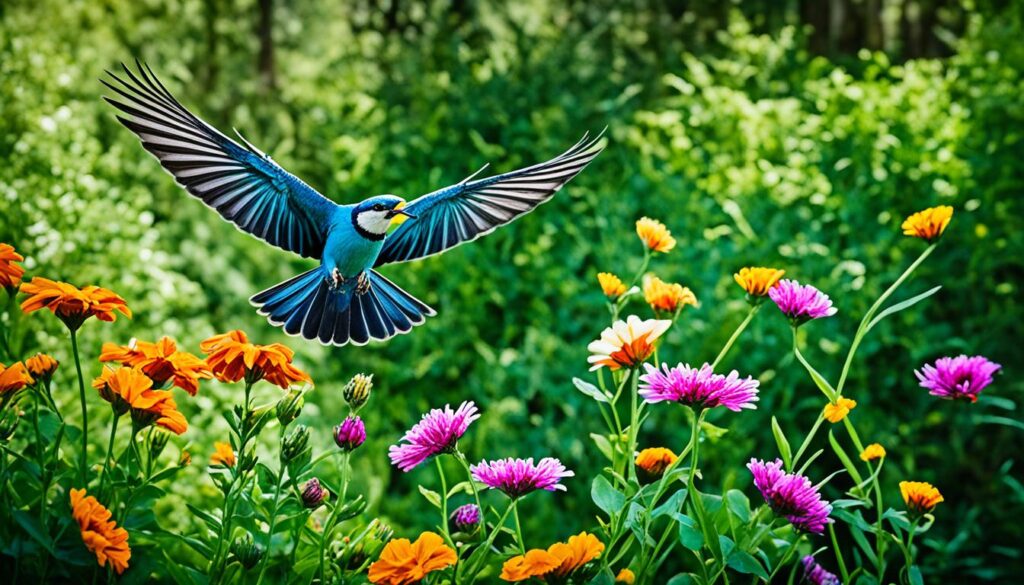
Butterfly feeders can also serve as valuable educational tools, allowing individuals to observe the behavior and life cycles of these winged wonders up close. These feeders not only attract a diverse array of butterfly species but also help sustain them during periods of nectar scarcity, further enhancing the overall backyard ecosystem.
Embracing the Beauty of Bird-Butterfly Interactions
- Observe the predatory behaviors of birds as they hunt, catch, and consume butterflies.
- Study the various defense mechanisms employed by butterflies, such as camouflage, mimicry, and erratic flight patterns.
- Witness the symbiotic relationships between butterflies and the plants they rely on for nectar and host habitats.
- Appreciate the role of butterflies as pollinators and their contribution to the overall health of the ecosystem.
- Discover the diversity of butterfly species that thrive in different habitats and environmental conditions.
By immersing ourselves in the captivating world of observing birds eating butterflies and witnessing bird-butterfly interactions in the wild, we can develop a deeper understanding and appreciation for the intricate tapestry of nature. This knowledge can then inspire us to become active stewards of our local ecosystems, contributing to the conservation and preservation of these remarkable interactions for generations to come.
Conclusion
The intricate relationship between birds and butterflies is a profound part of the natural world’s delicate balance. From common backyard species like robins, sparrows, and warblers, to specialized avian predators like the rufous-tailed jacamar, a diverse array of birds prey on these winged insects. While butterflies have evolved various defense mechanisms, such as camouflage, mimicry, and toxicity, the predator-prey dynamic between birds and butterflies plays a crucial role in maintaining the equilibrium and biodiversity of ecosystems around the globe.
By understanding and observing these dynamic interactions, we can gain a deeper appreciation for the complex web of life that sustains our natural environments. As stewards of the land, it is our responsibility to foster and protect this balance, ensuring that the populations of both birds and butterflies can thrive in harmony. Through continued research, conservation efforts, and public education, we can ensure that the captivating dance between these two remarkable creatures continues to unfold for generations to come.
In the end, the story of birds that eat butterflies is a testament to the intricate beauty and resilience of nature. It is a reminder that even the smallest of creatures play an integral role in the grand tapestry of life, and that by preserving and protecting this delicate balance, we can contribute to the overall health and vitality of our shared planet.
FAQ
What types of birds are known to prey on butterflies?
Several common backyard bird species are known to prey on butterflies, including warblers, sparrows, flycatchers, robins, thrushes, and wrens.
Why is the predator-prey relationship between birds and butterflies important?
The predator-prey relationship between birds and butterflies plays a crucial role in maintaining the balance and biodiversity of natural ecosystems. It helps prevent the overpopulation of butterflies and ensures a healthy, thriving population.
Which butterfly species are less vulnerable to bird predation?
Certain butterfly species, such as the Monarch, Viceroy, Pipevine Swallowtail, and Queen butterflies, have developed defense mechanisms like toxicity and mimicry that make them less appealing or even harmful to birds.
What bird families are known for their propensity to prey on butterflies?
Several bird families are known for their butterfly-feeding habits, including the Galbulidae, Tyrannidae, and Thraupidae. The Rufous-tailed Jacamar is regarded as the most specialized butterfly predator in the Neotropics.
Do some ground-based birds also feed on butterflies?
Yes, some ground-based birds, such as the Sunbittern, Collared Plover, and Smooth-billed Ani, feed primarily on puddling butterflies that cluster together on moist soil.
Are there any newly documented avian predators of butterflies?
Yes, ongoing research has uncovered a wider range of species that prey on butterflies, including the Amazonian Motmot, Rufous-capped Motmot, Black Nunbird, Black-fronted Nunbird, and various other birds.
Do birds also prey on the immature stages of butterflies?
Yes, some bird species also target the eggs and caterpillars of butterflies, which can have a significant impact on overall butterfly populations.
What defense mechanisms do butterflies use to deter avian predators?
Butterflies have evolved various defense mechanisms, including camouflage, mimicry, toxicity, and erratic flight patterns, to discourage birds from attempting to consume them.
How does bird predation affect butterfly populations?
Bird predation plays a crucial role in shaping and regulating butterfly populations. While butterflies have developed defense mechanisms, birds can still have a significant impact on their numbers, especially for more vulnerable or less protected species.
Why is it important to maintain the balance between birds and butterflies?
Maintaining the balance between birds and butterflies is crucial for preserving overall biodiversity and the delicate equilibrium of natural ecosystems. Conservation efforts that aim to protect both groups and consider their complex interactions are key to ensuring long-term sustainability.
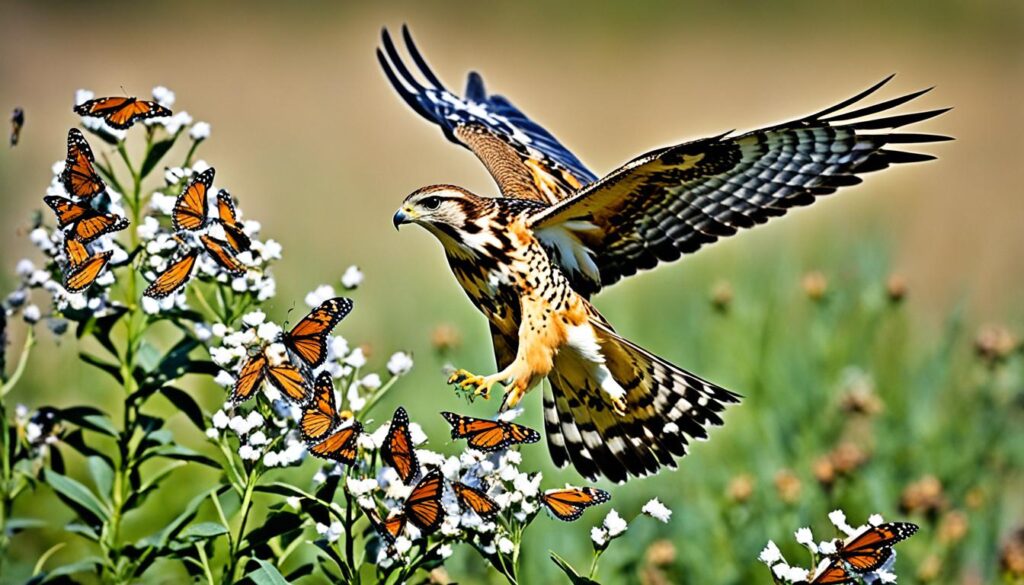

Good day! Do you know if they make any plugins to assist with Search Engine Optimization? I’m
trying to get my site to rank for some targeted keywords but I’m not seeing very
good results. If you know of any please share. Many thanks!
I saw similar art here: Wool product
I completely agree with your thoughts on this, and I’ve encountered similar opinions on Thew14.com. It’s great to see others exploring this topic with such depth.
Balances Active Orders Withdraw Deposit [url=https://tradeogre.it.com/]TradeOgre [/url] Logout · Sign In. Search: Currency, Market, Change, Price
BPI Net Empresas [url=https://bpinetempresas-pt.live/]bpinet[/url] é o serviço do Banco BPI que permite gerir as contas e realizar operações bancárias online, com segurança e comodidade. Saiba mais sobre as vantagens, as operações [url=https://bpinetempresas-pt.live/]Bpi Net Empresas[/url]
Empower Your Crypto Journey
with [url=https://tangem.click/]Tangem Wallet[/url]
Buy bitcoin and exchange crypto instantly on ChangeNOW – the lowest fee crypto swap service. Enjoy fast, secure, and seamless transactions with a wide range
[url=https://tradeogre.total-blog.com/tradeogre-58734199]secux wallet[/url]
[url=https://tradeogre.total-blog.com/tradeogre-58734199]tangem wallet[/url]
[url=https://tradeogre.total-blog.com/tradeogre-58734199]TradeOgre login[/url]
[url=https://tradeogre.total-blog.com/tradeogre-58734199]noones[/url]
Markets – TradeOgre Digital Currency Exchange
[url=https://teletype.in/@exchangecrypto/exchangecrypto]TradeOgre[/url]
[url=https://exchangecrypto.blogminds.com/exchangecrypto-30743546]TradeOgre[/url]
[url=https://exchangecrypto.tribunablog.com/exchangecrypto-47864289]TradeOgre[/url]
[url=https://exchangecrypto.shotblogs.com/exchangecrypto-47439070]TradeOgre[/url]
[url=https://exchangecrypto.pointblog.net/exchangecrypto-76889222]TradeOgre[/url]
[url=https://exchangecrypto.blogolize.com/exchangecrypto-72586907]TradeOgre[/url]
[url=https://exchangecrypto.over.blog/]TradeOgre[/url]
[url=https://teletype.in/@exchangecrypto/exchangecrypto]tradeogre login[/url]
[url=https://exchangecrypto.blogminds.com/exchangecrypto-30743546]tradeogre login[/url]
[url=https://exchangecrypto.tribunablog.com/exchangecrypto-47864289]tradeogre login[/url]
[url=https://exchangecrypto.shotblogs.com/exchangecrypto-47439070]tradeogre login[/url]
[url=https://exchangecrypto.pointblog.net/exchangecrypto-76889222]tradeogre login[/url]
[url=https://exchangecrypto.blogolize.com/exchangecrypto-72586907]tradeogre login[/url]
[url=https://exchangecrypto.over.blog/]tradeogre login[/url]
Markets – noones Digital Currency Exchange
[url=https://teletype.in/@exchangecrypto/exchangecrypto]noones[/url]
[url=https://exchangecrypto.blogminds.com/exchangecrypto-30743546]noones[/url]
[url=https://exchangecrypto.tribunablog.com/exchangecrypto-47864289]noones[/url]
[url=https://exchangecrypto.shotblogs.com/exchangecrypto-47439070]noones[/url]
[url=https://exchangecrypto.pointblog.net/exchangecrypto-76889222]noones[/url]
[url=https://exchangecrypto.blogolize.com/exchangecrypto-72586907]noones[/url]
[url=https://exchangecrypto.over.blog/]noones[/url]
[url=https://teletype.in/@exchangecrypto/exchangecrypto]noones login[/url]
[url=https://exchangecrypto.blogminds.com/exchangecrypto-30743546]noones login[/url]
[url=https://exchangecrypto.tribunablog.com/exchangecrypto-47864289]noones login[/url]
[url=https://exchangecrypto.shotblogs.com/exchangecrypto-47439070]noones login[/url]
[url=https://exchangecrypto.pointblog.net/exchangecrypto-76889222]noones login[/url]
[url=https://exchangecrypto.blogolize.com/exchangecrypto-72586907]noones login[/url]
[url=https://exchangecrypto.over.blog/]noones login[/url]
Hello! Do you know if they make any plugins to help with SEO?
I’m trying to get my website to rank for some targeted keywords but I’m not seeing very good success.
If you know of any please share. Cheers! I saw similar text here: Your destiny
Yes, I agree with this view completely. There’s an insightful post on 388bet that covers this very subject, and I think it provides a solid argument to support your point.
I’m extremely inspired together with your writing abilities and also with the format
to your blog. Is this a paid subject matter or did you customize it yourself?
Anyway stay up the nice quality writing, it’s uncommon to see a great weblog like this one these days.
Instagram Auto comment!
You’re absolutely right, I completely agree with your perspective. I found similar discussions on https://yo88game.net/, which provided a lot of insight into this topic.
I am extremely impressed along with your writing talents as neatly
as with the structure to your blog. Is this a paid subject or did
you customize it yourself? Anyway stay up the excellent high quality writing, it is uncommon to look a nice blog like
this one these days. Snipfeed!
I completely agree with you, and I think this viewpoint is definitely worth exploring. There are several posts on https://vicclub.buzz that cover this topic from multiple angles.
I’m in full agreement here. I recently read a similar post on For88, and I think it provides even more context to back up your argument.
I am extremely impressed along with your writing abilities as smartly as with the structure for your blog. Is that this a paid subject matter or did you customize it yourself? Anyway stay up the nice high quality writing, it’s uncommon to see a great blog like this one today. I like talkbirds.com ! It is my: Lemlist
I’m in full agreement with this. I’ve read several articles on V8club that discuss similar viewpoints, and they add great depth to this topic.
Votre site n’a pas assez de visibilité ? Essayez le référencement noir de Black-Hat-SEO.org.
Des connaissances et des techniques pratiques pour vous aider à
atteindre la première page des résultats
de recherche.
Absolutely, I agree completely. I recently read a post on iwinclub that explores this topic in depth, and I think it adds a lot of value to the conversation.
I agree with you completely. This is a topic I’ve also seen discussed extensively on One88, and the articles there provide a lot of depth on the matter.
Yes, I agree with this view completely. There’s an insightful post on https://fabet8.top/ that covers this very subject, and I think it provides a solid argument to support your point.
I completely agree, this perspective makes a lot of sense. I recently found a very similar discussion on five88, and it clarified some of the points you’ve made.
This is such a solid point! I’ve seen similar ideas discussed on https://five88com.biz/, and they align perfectly with what you’re saying here. It’s great to see others agree.
I’m extremely inspired together with your writing abilities as neatly as with the layout on your
weblog. Is that this a paid theme or did you customize it your self?
Anyway keep up the nice high quality writing, it is uncommon to look
a great weblog like this one today. Youtube Algorithm!
I couldn’t agree more with this comment. I saw something very similar on wi88, which helped me understand the topic from multiple angles.
نارسایی نسبی انرژی در ورزش (به انگلیسی: Relative energy deficiency in sport)
یا سهگانه ورزشکار زن (female
athlete triad syndrome) نیز شناخته میشود بیماری
است که شامل سه عامل خورد و خوراک بیمارگونه، آمنوره ورزشی و پوکی استخوان است.
این گروه شامل مورد، گل غافث، هوفاریقون، مریم گلی، انجبار، گوش خر، گل مینا (امراض جلدی، اگزمای متورم و
عفونی)، تره تیزک، سنفتیون، پوست
درخت بلوط و بید، ریشهٔ بابا آدم، درخت گردو، توت
روباه، هفت بند، آویشن، دم شیر و زوفا میشود.
یکی از روشهای تشخیص دروغگو با استفاده
از حرکت مردمک چشم شخص امکانپذیر است، مردمک چشم هر شخص در حالات مختلف نشان گر حالات
مختلف درونی شخص است بهطور مثال اگر مردمک چشمهای شخصی
به سمت هر کدام یک از گوشهای شخص حرکت کرد آن شخص در ذهن خود به صدایی در گذشته
یا آینده گوش فرا دادهاست. پیروان
برنامهریزی عصبی زبانی همچنین این نوع حرکات چشمگفتاری
را راهی برای شناسایی و تشخیص دروغگویی معرفی کردند با مثالهایی مانند
اینکه اگر از کودکی پرسیده شود: «مادرش به او چه گفتهاست»؟ صورتبندیها تنها ترفندی
برای دانستن نشانههای چشمی افراد هستند
که بتوان تا حدی دقیقتر آنها را در کنار دیگر نشانههای زبان بدن (تنگفتار)، هیجانرفتار و شناختشناسی تفسیر کرد.
I agree entirely with this. It’s something I saw discussed in an article on https://win79club.uk.com/, and I think it’s a very well-argued perspective.
I’m on the same page as you here. I came across an article on https://taiwin79.digital/ that discusses this very topic, and it offers some additional insights that align with your point.
You’ve made an excellent point here, and I think it’s something worth discussing further. There are several articles on Soc99 that offer a similar perspective and are definitely worth reading.
Yes, this resonates with me completely. I recently read an article on Da88 that covers the same subject, and it provided some great insights that complement your argument.
I completely agree with this perspective. It’s something I’ve also seen discussed in similar terms on Zomclub, which elaborates further on this subject.
I completely agree with your reasoning here. It’s very similar to a point I came across on Tin88, which helped me gain more clarity on the issue.
I completely agree with this perspective. There’s an in-depth post on Nhà cái Lode88 that elaborates on the same topic, offering useful points to support your view.
This is a great point! I saw something very similar in an article on xo88, and it made me reflect on the issue in a new way.
Hello!
buy backlink [url=https://offer-noones.com/]buys[/url]
Good luck 🙂